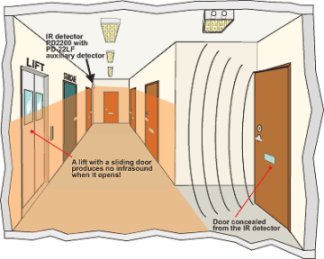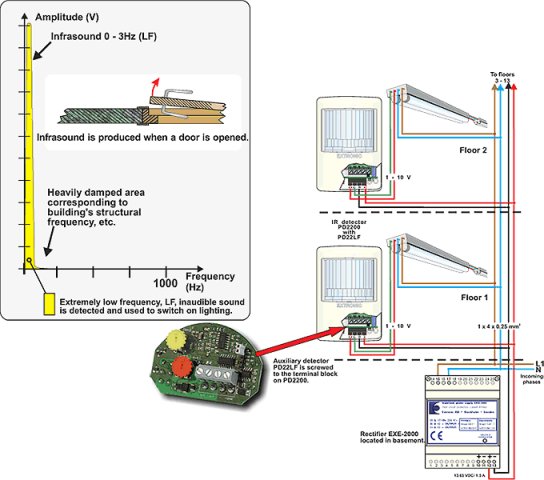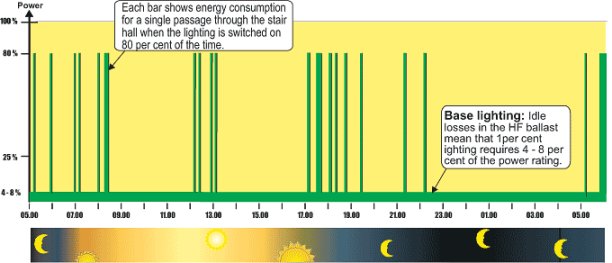4C. Floor in stairwell with IR detector and auxiliary detector with level selector
Dimmable HF operating devices
Svenskt patent nr. 9201493-5, English patent No. 0659329
| Premises and light sources
Replacement of light fittings in the lift halls of residential blocks with fittings using dimmable HF devices with 1 – 10 V control has several advantages. In addition to the built-in advantages of flicker-free light and lower energy consumption, it allows the possibility of cost-effective presence control of the lighting. In the lift halls it is appropriate to use the PD-2200 IR detector supplemented by a PD-22LF auxiliary detector. On every floor presence is detected by an IR detector. The PD-22LF auxiliary detector built into every IR detector features an acoustic detector that detects low frequencies caused by an opening door (LF, 0-3 Hz) and a level selector. The level selector switches between the normal light level of about 80 per cent and the basic light level of about 2 per cent.
 An EXE-2000 rectifier for power supply for the IR detectors on all 13 floors in the electrical cabinet in the cellar. Always draw up an electricity budget! Information for current budget
|

Control system Upon entry into the lift hall the lighting is activated at normal level by the acoustic auxiliary detector that detects the infrasounds (0-3 Hz) arising when a door opens. The acoustic detector has the advantage of also detecting entry into the stairwell hall through doors concealed from the IR detector. The sliding lift doors do not produce any infrasound when they open. The lighting is then activated as a result of detection by the IR detector positioned so it directly detects people leaving the lift. The lighting remains switched on at normal level for as long as presence is detected by the IR detector, plus a delay that can be set by a strap on the auxiliary detector (2 sec, 10 sec, 30 sec, 1 min or 5 min). After this the lighting is dimmed to a basic level that is dependent on the fittings, and can vary from 1 per cent to 10 per cent. The basic light stays on until the next time someone enters the lift hall. The power supply for the detectors on all floors (in this case 13 floors) uses an EXE-2000 rectifier. It should be positioned on floor 7 to minimise the voltage drop in long lines or in the cellar. If there is no suitable wiring duct between the floors a rectifier is necessary on every floor. The lighting in the separate evacuation stairwell is controlled by an AD-600 acoustic detector and three AD-260 microphones (see application example 4A). NB: With acoustic detection it is a prerequisite for the stairwell to be closed, i.e. for there to be doors that are normally closed to all other areas. Lens choice To get the best performance it is very important that you use the right lens! Positioning of detectors See application example 2A for positioning of the IR detector. |
||||||||||||||||
 |
|||||||||||||||||
| Lighting control in stair hall
The yellow area shows the energy consumption without lighting control when the lighting is on 24 hours per day. |
|||||||||||||||||
 |
|||||||||||||||||






